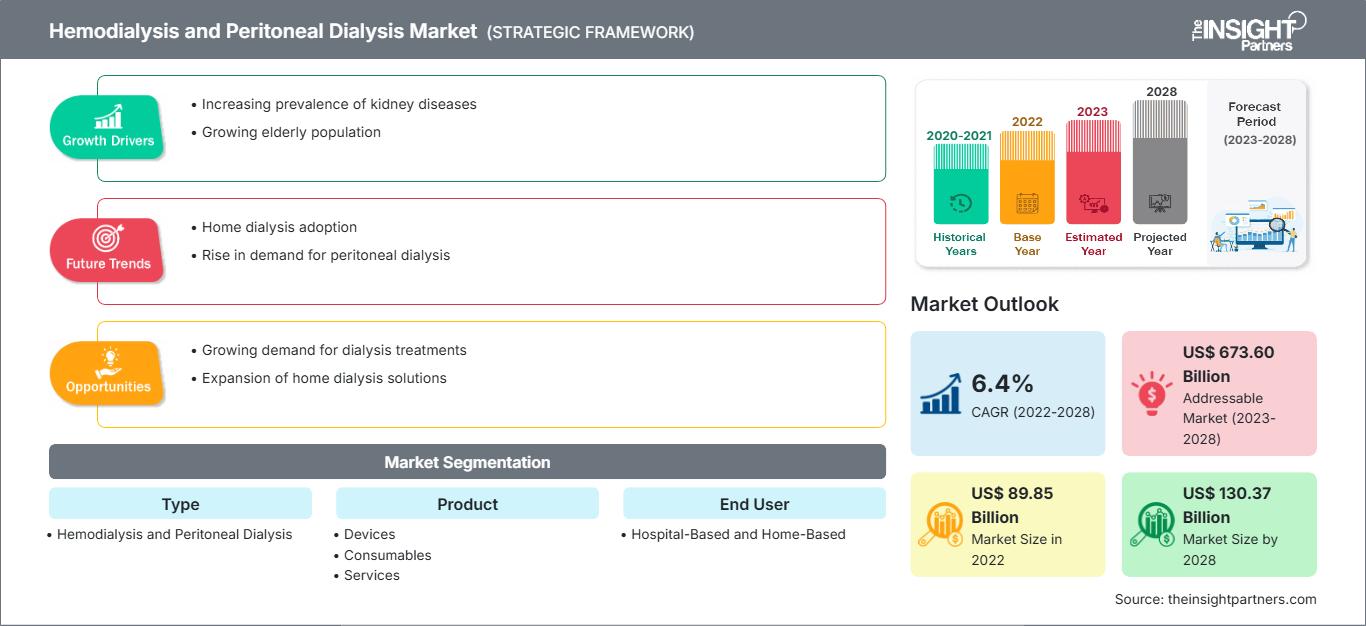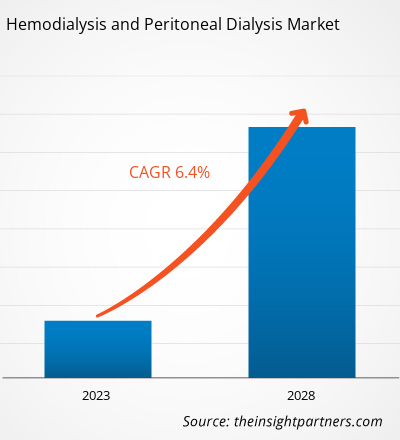Der Markt für Hämodialyse und Peritonealdialyse soll von 89.851,61 Millionen US-Dollar im Jahr 2022 auf 130.370,18 Millionen US-Dollar im Jahr 2028 anwachsen; von 2022 bis 2028 wird ein CAGR-Wachstum von 6,4 % erwartet.
Es gibt zwei Arten der Dialyse. Bei der Hämodialyse wird Blut aus dem Körper des Patienten in eine künstliche Niere gepumpt und über Schläuche, die an die Maschine angeschlossen sind, wieder in den Körper des Patienten zurückgeführt. Bei der Peritonealdialyse fungiert die Bauchdecke des Patienten als natürlicher Filter.
Der Markt für Hämodialyse und Peritonealdialyse ist nach Typ, Produkt, Endverbraucher und Geografie segmentiert. Geografisch ist der Markt grob in Nordamerika, Europa, Asien-Pazifik, den Nahen Osten und Afrika sowie Süd- und Mittelamerika unterteilt. Der Marktbericht für Hämodialyse und Peritonealdialyse bietet Einblicke und eine detaillierte Analyse des Marktes. Dabei werden Parameter wie Marktgröße, Trends, technologischer Fortschritt und Marktdynamik sowie die Wettbewerbslandschaft der weltweit führenden Marktteilnehmer hervorgehoben. Darüber hinaus berücksichtigt der Bericht die Auswirkungen der COVID-19-Pandemie auf den Hämodialyse- und Peritonealdialysemarkt in allen Regionen.
Das Wachstum des Hämodialyse- und Peritonealdialysemarktes ist auf die steigende Zahl von Patienten mit terminaler Niereninsuffizienz, die Zunahme von Nierenversagen und chronischer Nierenfunktionsstörung in der Bevölkerung sowie den Mangel an Organspendern zurückzuführen. Bedenken hinsichtlich der Kostenerstattung in Schwellenländern schränken das Marktwachstum jedoch ein.
Passen Sie diesen Bericht Ihren Anforderungen an
Sie erhalten kostenlos Anpassungen an jedem Bericht, einschließlich Teilen dieses Berichts oder einer Analyse auf Länderebene, eines Excel-Datenpakets sowie tolle Angebote und Rabatte für Start-ups und Universitäten.
Markt für Hämodialyse und Peritonealdialyse: Strategische Einblicke

- Holen Sie sich die wichtigsten Markttrends aus diesem Bericht.Dieses KOSTENLOSE Beispiel umfasst Datenanalysen, die von Markttrends bis hin zu Schätzungen und Prognosen reichen.
Sie erhalten kostenlos Anpassungen an jedem Bericht, einschließlich Teilen dieses Berichts oder einer Analyse auf Länderebene, eines Excel-Datenpakets sowie tolle Angebote und Rabatte für Start-ups und Universitäten.
Markt für Hämodialyse und Peritonealdialyse: Strategische Einblicke

- Holen Sie sich die wichtigsten Markttrends aus diesem Bericht.Dieses KOSTENLOSE Beispiel umfasst Datenanalysen, die von Markttrends bis hin zu Schätzungen und Prognosen reichen.
Markteinblicke
Steigende Prävalenz von Nierenerkrankungen treibt das Wachstum der Märkte für Hämodialyse und Peritonealdialyse voran
Chronische Nierenerkrankung (CKD) und akutes Nierenversagen (AKI) sind Erkrankungen, bei denen die Nieren geschädigt sind und das Blut nicht mehr richtig filtern können. Dadurch verbleiben überschüssige Flüssigkeit und Abfallprodukte aus dem Blut im Körper, was zu weiteren gesundheitlichen Problemen wie Herzerkrankungen und Schlaganfall führen kann. CKD verschlechtert sich in der Regel mit der Zeit, auch wenn die Behandlung einen langsamen Verlauf gezeigt hat. Bleibt CKD unbehandelt, kann es zu Nierenversagen und frühen Herz-Kreislauf-Erkrankungen kommen. Wenn bei CKD die Nieren ihre Funktion einstellen, ist eine Dialyse oder Nierentransplantation zum Überleben notwendig. Bei einer Behandlung mit Dialyse oder Nierentransplantation spricht man von terminaler Niereninsuffizienz (ESRD). Nach Angaben der Centers for Disease Control and Prevention (CDC) leiden in den USA etwa 36 Millionen Erwachsene an CKD. Darüber hinaus beginnen alle 24 Stunden 360 Menschen aufgrund von Nierenversagen eine Dialysebehandlung. Im Jahr 2017 wurden weltweit 697,5 Millionen Fälle von CKD (alle Stadien) registriert, was einer globalen Prävalenz von 9,1 % entspricht. Die zunehmende Prävalenz von ESRD ist ebenfalls einer der wichtigsten Faktoren, die den Markt antreiben. Laut dem United States Renal Data System (USRDS) beispielsweise leben fast 786.000 Menschen in den USA mit einer Nierenerkrankung im Endstadium (ESKD), auch bekannt als terminale Niereninsuffizienz (ESRD). Somit treibt die zunehmende Prävalenz von chronischer Nierenerkrankung, akutem Nierenversagen und terminaler Niereninsuffizienz, die zu einer Dialyse führt, den Markt für Hämodialyse und Peritonealdialyse an.
Typbasierte Erkenntnisse
Basierend auf dem Typ wird der Markt für Hämodialyse und Peritonealdialyse in Hämodialyse und Peritonealdialyse unterteilt. Im Jahr 2022 hielt das Hämodialysesegment einen größeren Marktanteil. Darüber hinaus wird für dasselbe Segment im Prognosezeitraum eine höhere durchschnittliche jährliche Wachstumsrate (CAGR) von 6,7 % erwartet.
Produktbasierte Erkenntnisse
Basierend auf dem Produkt ist der Markt für Hämodialyse und Peritonealdialyse in Geräte, Verbrauchsmaterialien und Dienstleistungen unterteilt. Das Dienstleistungssegment hielt im Jahr 2022 den größten Marktanteil. Es wird jedoch erwartet, dass das Verbrauchsmaterialsegment im Prognosezeitraum die höchste durchschnittliche jährliche Wachstumsrate (CAGR) von 7,5 % verzeichnet.
Endbenutzerbasierte Erkenntnisse
Basierend auf dem Endbenutzer ist der Markt für Hämodialyse und Peritonealdialyse in Krankenhaus- und Heimdialyse unterteilt. Das Krankenhaussegment hatte im Jahr 2022 einen größeren Anteil. Für das Segment der Heimdialyse wird jedoch im Prognosezeitraum eine höhere durchschnittliche jährliche Wachstumsrate (CAGR) von 7,4 % erwartet.
Die Akteure auf dem Markt für Hämodialyse und Peritonealdialyse verfolgen organische Strategien wie Produkteinführung und -erweiterung, um ihre Präsenz und ihr Produktportfolio weltweit zu erweitern und der wachsenden Nachfrage gerecht zu werden.
Hämodialyse und PeritonealdialyseRegionale Einblicke in den Markt für Hämodialyse und Peritonealdialyse
Die Analysten von The Insight Partners haben die regionalen Trends und Faktoren, die den Markt für Hämodialyse und Peritonealdialyse im Prognosezeitraum beeinflussen, ausführlich erläutert. In diesem Abschnitt werden auch die Marktsegmente und die geografische Lage in Nordamerika, Europa, dem asiatisch-pazifischen Raum, dem Nahen Osten und Afrika sowie Süd- und Mittelamerika erörtert.
Umfang des Marktberichts zur Hämodialyse und Peritonealdialyse
| Berichtsattribut | Einzelheiten |
|---|---|
| Marktgröße in 2022 | US$ 89.85 Billion |
| Marktgröße nach 2028 | US$ 130.37 Billion |
| Globale CAGR (2022 - 2028) | 6.4% |
| Historische Daten | 2020-2021 |
| Prognosezeitraum | 2023-2028 |
| Abgedeckte Segmente |
By Typ
|
| Abgedeckte Regionen und Länder | Nordamerika
|
| Marktführer und wichtige Unternehmensprofile |
|
Dichte der Marktteilnehmer im Bereich Hämodialyse und Peritonealdialyse: Verständnis ihrer Auswirkungen auf die Geschäftsdynamik
Der Markt für Hämodialyse und Peritonealdialyse wächst rasant. Dies wird durch die steigende Endverbrauchernachfrage aufgrund veränderter Verbraucherpräferenzen, technologischer Fortschritte und eines stärkeren Bewusstseins für die Produktvorteile vorangetrieben. Mit der steigenden Nachfrage erweitern Unternehmen ihr Angebot, entwickeln Innovationen, um den Bedürfnissen der Verbraucher gerecht zu werden, und nutzen neue Trends, was das Marktwachstum weiter ankurbelt.

- Holen Sie sich die Markt für Hämodialyse und Peritonealdialyse Übersicht der wichtigsten Akteure
Nach Geografie
Geografisch ist der Markt für Hämodialyse und Peritonealdialyse in Nordamerika (USA, Kanada und Mexiko), Europa (Großbritannien, Deutschland, Frankreich, Italien, Spanien und übriges Europa), Asien-Pazifik (China, Japan, Indien, Australien, Südkorea und übriger Asien-Pazifik-Raum), Naher Osten und Afrika (VAE, Saudi-Arabien, Südafrika und übriger Naher Osten und Afrika) sowie Süd- und Mittelamerika (Brasilien, Argentinien und übriges Süd- und Mittelamerika) unterteilt. Einige der führenden Akteure auf diesem Markt sind Fresenius Medical Care AG & Co KGaA; DaVita Inc.; Baxter International Inc.; B. Braun Melsungen AG; Diaverum; Nipro Medical Corporation; Asahi Kasei Medical Co., Ltd.; Rockwell Medical, Inc. und Dialife SA.
- Historische Analyse (2 Jahre), Basisjahr, Prognose (7 Jahre) mit CAGR
- PEST- und SWOT-Analyse
- Marktgröße Wert/Volumen – Global, Regional, Land
- Branchen- und Wettbewerbslandschaft
- Excel-Datensatz
Aktuelle Berichte
Erfahrungsberichte
Grund zum Kauf
- Fundierte Entscheidungsfindung
- Marktdynamik verstehen
- Wettbewerbsanalyse
- Kundeneinblicke
- Marktprognosen
- Risikominimierung
- Strategische Planung
- Investitionsbegründung
- Identifizierung neuer Märkte
- Verbesserung von Marketingstrategien
- Steigerung der Betriebseffizienz
- Anpassung an regulatorische Trends




















 Kostenlose Probe anfordern für - Markt für Hämodialyse und Peritonealdialyse
Kostenlose Probe anfordern für - Markt für Hämodialyse und Peritonealdialyse